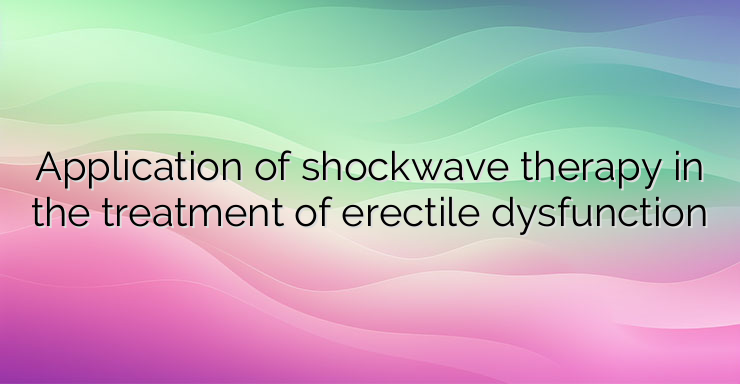Erectile dysfunction is defined as the persistent or recurring inability to achieve or maintain an erection during sexual intercourse. Impotence has a significant prevalence and affects approximately 40% of men between the ages of 40-49 and over 90% of men over the age of 70. Risk factors for the development of erectile dysfunction include some concomitant diseases such as diabetes mellitus, cardiovascular diseases, arterial hypertension, obesity, metabolic syndrome, in particular dyslipidemia. In addition, interventions in the pelvis or lower abdomen, benign prostatic hyperplasia and mental disorders can cause it to develop. Smoking, certain medications such as antidepressants, and hormonal abnormalities are other well-defined risk factors. The guidelines of the European Association of Urology for Sexual and Reproductive Health define three categories of erectile dysfunction – organic, psychogenic and mixed. However, most cases of erectile dysfunction are classified as mixed type, as both organic and psychological factors are usually involved. Diagnosis of the condition involves a detailed medical history and past illnesses. Laboratory evaluation is aimed at examining testosterone and luteinizing hormone levels to evaluate cases of synchronous hypogonadism. In addition, a study of lipid profile, fasting blood sugar and levels of glycated hemoglobin in the blood is necessary. Treatment of impotence is complex and aimed at treating the underlying cause of the condition. Lifestyle changes, such as weight loss programs and regular exercise, have resulted in improved erectile function and should therefore be the first behavioral recommendation. Treatment of cardiovascular risk factors, such as treatment of arterial hypertension and dyslipidemia, is also important in influencing the condition. Beta-blockers, thiazide diuretics, and other medications known to impair erectile function should be replaced with a more appropriate class of medication. Psychosexual therapy and working with a sexual health counselor have a beneficial effect in influencing psychogenic forms of erectile dysfunction. Pharmacologic therapy includes phosphodiesterase-5 inhibitors as first-line medications of choice. However, they carry a risk of side effects because they interact with many other classes of medications, such as antidepressants, antifungals, antiretrovirals, and antihypertensive drugs. They can cause potentially dangerous hypotension, especially in combination with nitrates used to treat ischemic heart disease. Shockwave therapy is a relatively new method introduced in the treatment of patients with erectile dysfunction. Shockwave therapy for the treatment of impotence is also called Low Intensity Shockwave Therapy (LiSWT),focused shock wave therapy (FSWT) or extracorporeal shock wave therapy (ESWT). It was introduced using a borrowed method for extracorporeal shock wave treatment of kidney stones. A device produces a sound (shock) wave that carries energy and can be directed and focused on a selected anatomical area. When shock wave therapy is applied to the penis, the acoustic waves interact with the tissue and trigger a cascade of biological reactions. The main benefits are stimulation of neovascularization and tissue regeneration. This is achieved through the release of endothelial growth factor (VEGF) in them, which in turn leads to the formation of new blood vessels with a subsequent improvement in the blood circulation of the penis and, accordingly, the erection. The method is particularly useful for treatment after prostatectomy or nerve ending damage as a result of spinal cord injury or surgery where there is damage to the neurovascular bundles. The delivery of the shock waves is aimed at the corpora cavernosa, the root, the middle part and the tip of the penis. The treatment is carried out in several sessions, each of which lasts 10-15 minutes. The number and frequency of sessions varies depending on the severity of the disease. It takes place from once a week for four weeks to once a week for 12 weeks, and sometimes more often. The therapy is relatively safe and few and harmless side effects have been reported. The most common of these are blood clots and hematomas in the penile area. Hematuria, penile skin infection, painful erection, and difficulty with intercourse due to infection or pain may be other potential adverse effects. References: https://www.ncbi.nlm.nih.gov/pmc/articles/PMC9995960/ https://www.urologyhealth.org/healthy-living/care-blog/2022/shockwave-therapy-for-erectile- dysfunctioneach of which lasts 10-15 minutes. The number and frequency of sessions varies depending on the severity of the disease. It takes place from once a week for four weeks to once a week for 12 weeks, and sometimes more often. The therapy is relatively safe and few and harmless side effects have been reported. The most common of these are blood clots and hematomas in the penile area. Hematuria, penile skin infection, painful erection, and difficulty with intercourse due to infection or pain may be other potential adverse effects. References: https://www.ncbi.nlm.nih.gov/pmc/articles/PMC9995960/ https://www.urologyhealth.org/healthy-living/care-blog/2022/shockwave-therapy-for-erectile- dysfunctioneach of which lasts 10-15 minutes. The number and frequency of sessions varies depending on the severity of the disease. It takes place from once a week for four weeks to once a week for 12 weeks, and sometimes more often. The therapy is relatively safe and few and harmless side effects have been reported. The most common of these are blood clots and hematomas in the penile area. Hematuria, penile skin infection, painful erection, and difficulty with intercourse due to infection or pain may be other potential adverse effects. References: https://www.ncbi.nlm.nih.gov/pmc/articles/PMC9995960/ https://www.urologyhealth.org/healthy-living/care-blog/2022/shockwave-therapy-for-erectile- dysfunction


Leave a Reply